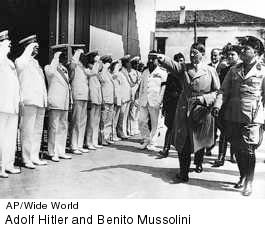
9. Totalitarian states attempt to control artists (throughout the 1900's)
The increasing totalitarianism,
including the rise of such dictators as Benito Mussolini of Italy, Adolf
Hitler of Germany, and Francisco Franco of Spain, led to attempts to
suppress modern art. Russia banned abstract art in 1922. Early 20th
century masters, especially German Expressionists, were deemed "degenerate"
in Germany (1937). Governments sponsored social realism as the only
acceptable style.
Surrealist artists combined
Freudian dreams with magic realism in warning and protest.

Pablo Picasso combined elements
of Cubism and Surrealism in his monumental mural painting Guernica
(1937), a devastating commentary on the bombing of that Basque city
during the Spanish Civil War (1936-1939). This attack was an early warning
of the mass destruction of civilians by aerial attacks in World War
II (1939-1945). The Nazi attempt to exterminate the Jewish people in
the Holocaust caused a mass exodus from Germany and Austria. Jewish
artists, scholars, and teachers moved to the United States, profoundly
influencing American art, art criticism, patronage, teaching, and scholarship
in art. New York City replaced Paris as the Western world's art center,
and Bauhaus architects and artists of Germany regrouped in Chicago (1937).
Government control and repression of the arts continued under Communist
regimes, most devastatingly seen in the Chinese Cultural Revolution
(1966-1976).
|


